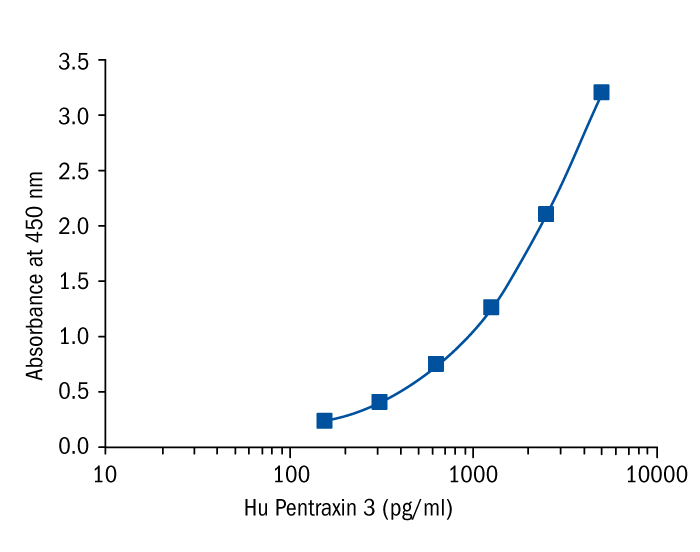Features
- It is intended for research use only
- The total assay time is less than 3.5 hours
- The kit measures PTX3 in serum, plasma (EDTA, citrate, heparin), saliva and stool extract
- For protocol for preparation of stool extracts and other details, please contact us at info@biovendor.com
- Assay format is 96 wells
- Standard is recombinant protein based
- Components of the kit are provided ready to use, concentrated or lyophilized
Research topic
Cardiovascular disease, Immune Response, Infection and Inflammation
Summary
Pentraxin 3 (PTX3, TSG14, Tumor necrosis factor alpha-induced protein 5, Tumor necrosis factor-inducible gene 14 protein) is an evolutionarily conserved, multimeric acute phase inflammatory glycoprotein in the same family as the well-established cardiovascular biomarker C-reactive protein (CRP). It is the prototypical long pentraxin, exhibiting a C-terminal pentraxin domain characteristic of the family, and a unique N-terminal domain [1,13]. PTX3 is mainly produced at extrahepatic sites by several cell types, including cells of the myelomonocyte lineage (monocytes, macrophages, dendritic cells), endothelial cells, smooth muscle cells, fibroblasts, and adipocytes.
PTX3 is also produced during neutrophil differentiation and stored in specific granules of mature neutrophils, ready to be released upon microbial recognition. PTX3 behaves as an acute phase response protein, as the blood levels of PTX3, low in normal conditions (<2 ng/ml in humans), increase rapidly (peaking at 6–8 hours after induction) and dramatically (200–800 ng/ml) during endotoxic shock, sepsis, and other inflammatory and infectious conditions, correlating with the severity of the disease. PTX3 has multiple complex nonredundant functions, ranging from assembly of a hyaluronic acid–rich extracellular matrix and female fertility to protection against pathogens (i.e., Aspergillus fumigatus, influenza viruses). PTX3 also regulates the clearance of apoptotic cells and may participate in maintenance of immunologic tolerance [13]. PTX3 is expressed in response to proinflammatory signals, including bacteria, IL-1 (but not IL-6), and TN-alpha produced primarily by endothelial cells, neutrophils, and macrophages. As a result, inflammation diseases, especially disorders of the immune system such as rheumatoid arthritis, progressive systemic sclerosis, Churg-Straus syndrome, Wegener’s granulomatosis, and microscopic polyangiitis, as well as systemic inflammatory response syndrome (SIRS), result in increased expression of plasma PTX3.
PTX3 is elevated in critically ill patients, with a gradient from systematic inflammatory response syndrome to septic shock, and in several other diseases, such as myocardial infarction, atherosclerosis, small vessel vasculitis and psoriasis. Plasma PTX3 levels have also been suggested to be a good marker for the response to treatment of patients with obstructive sleep apnea (OSA). PTX3 may also be a good diagnostic marker for deterioration in patients with inflammatory bowel disease.
Pentraxin 3 has been proposed as a marker of endothelial dysfunction and inflammation in pre-eclampsia. Pentraxin 3 levels have been found to be elevated in normal pregnancy and also shown to be significantly higher at the time of diagnosis of pre-eclampsia when compared with normal pregnancy. PTX3 may also be elevated in malignancies such as lung carcinoma, prostate cancer and liposarcomas.


